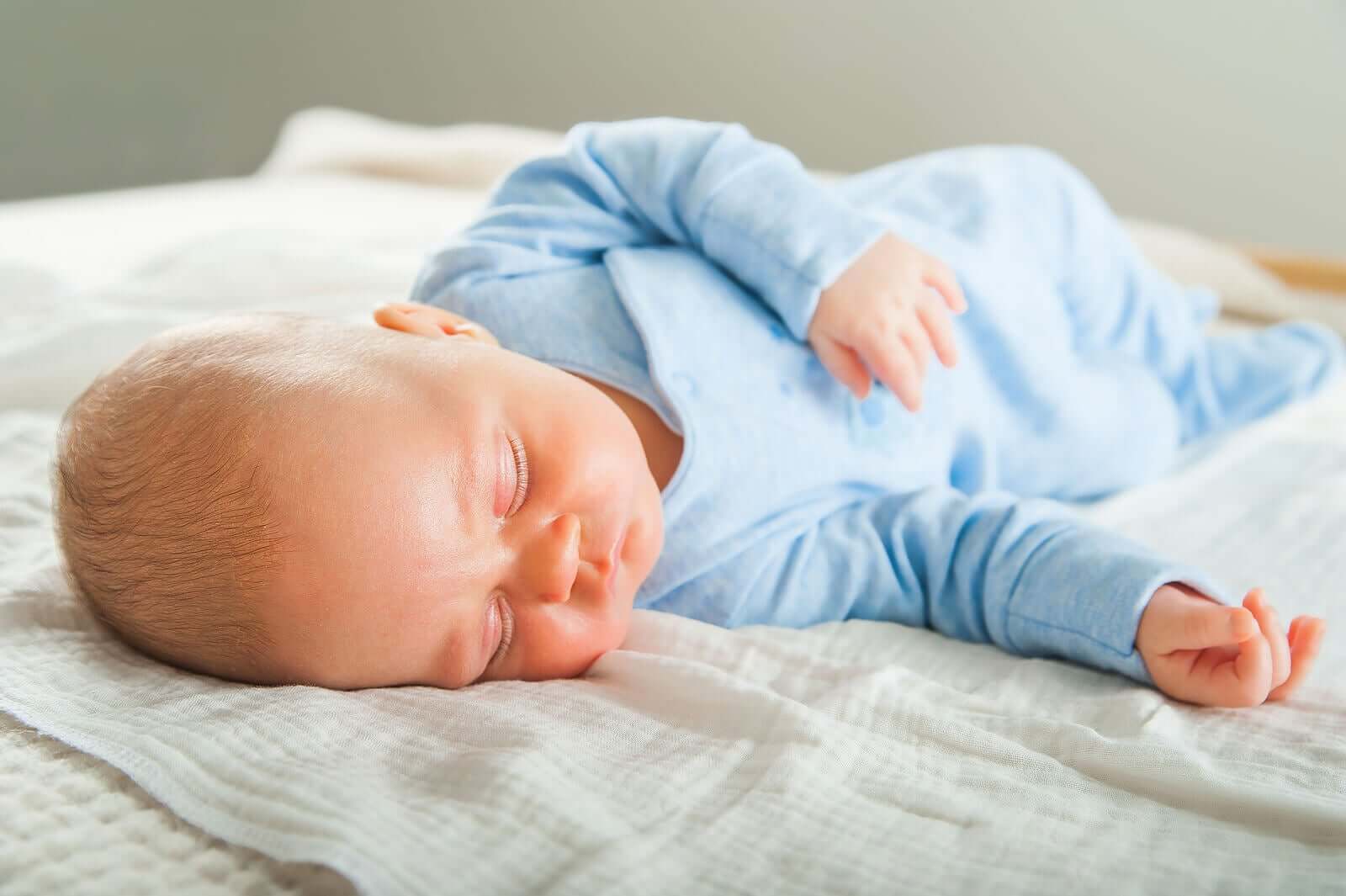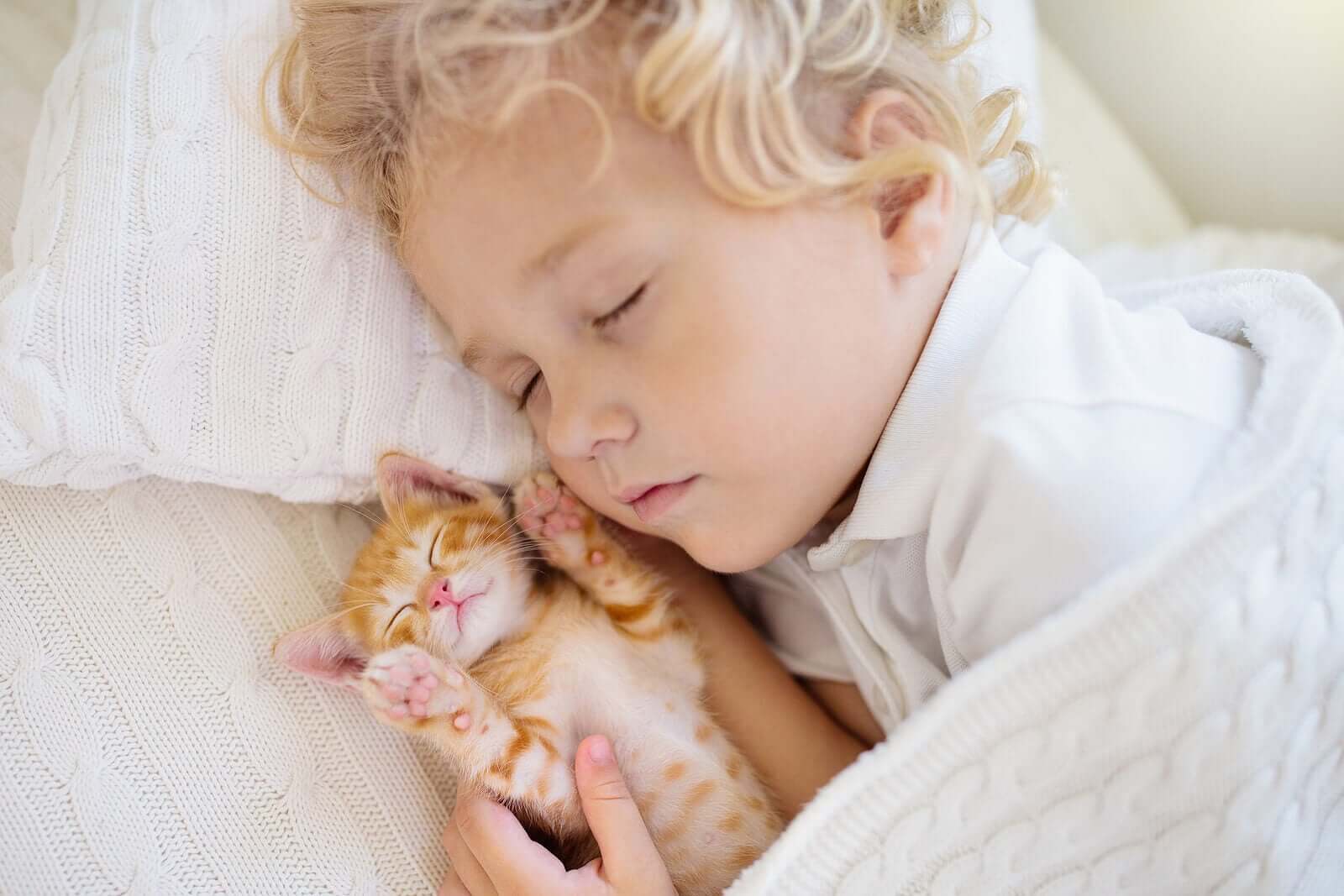How Do Babies' Sleep Patterns Evolve as They Grow?

Babies’ sleep patterns change as they get older. If a child doesn’t get enough sleep, then it has consequences for his or her physical and mental health, as well as repercussions for the rest of the family.
As parents, we certainly remember all those nights of constantly interrupted sleep to feed our child. Of course, we would all have liked to get a good night’s sleep, but the way babies and children sleep is different as they grow up.
How do those changes in infant sleep patterns happen? How many hours should babies and children sleep? We’ll answer these questions in the next few lines.
Babies’ sleep patterns evolve as they grow
To begin with, we have to say that babies’ sleep patterns evolve, that is, they change with the age of the child. Babies from 0 to 4 months old have to learn to sleep, so a 3-month-old can’t sleep the same as a 7-year-old. Each one of them has different needs and so their sleep can’t be the same either.
Circadian rhythms are responsible for controlling sleep. They regulate the amount of the melatonin we need – this is the hormone that relaxes us. In addition, it controls how much of the stress hormone (cortisol) must be secreted. These rhythms are regulated by the alternation of day and night, and are also key to cell regeneration, brain activity, among other things.

In babies under 4 months old, circadian rhythms still haven’t kicked into action, as they’re regulated by sunlight, and a baby still hasn’t started to distinguish when it’s day and when it’s night. That’s the reason why they still don’t have the necessary sleep patterns to help them fall asleep. These will develop later on.
How do babies sleep during their first few months?
Until they’re 4 months old, babies fall asleep and wake up according to other needs – either because they’re hungry, thirsty or uncomfortable. Their sleep cycles usually last around 40 or 50 minutes.
It’s from the age of 4 months when their sleep patterns begin to follow these circadian rhythms. It occurs through five sleep phases in all: one REM and four No REM. At this point, their sleep cycles can last from 90 to 120 minutes.
This is, therefore, the time to establish the sleep patterns that we want to teach them to follow. From this moment, the hours of daily sleep the child needs will decrease little by little as they grow.
How many hours should a child sleep according to their age?
In the same way as with adults, when a child doesn’t sleep the time they need they feel more irritable, can’t concentrate as well, and they have diminished abilities when carrying out different tasks.
So, as parents, one of our biggest questions is how many hours of sleep children need as they grow up. We’re going to try to answer this question by taking into account the information provided by the American Pediatric Association.
A newborn baby’s sleep
Newborn babies need to sleep many hours a day, as they’re still developing in many ways. This means they can sleep for 17 hours or more, both during the day and at night.
Between 4 and 12 months
During these ages, babies need to sleep 12 to 16 hours a day.
- From 4-5 months, 4 hours of sleep during the day (divided into 3 naps).
- From 6 months, 3 hours during the day (2 naps per day).
Sleep in babies from 1 to 2 years old
Including naps, babies between 1 and 2 years of age need 11 to 14 hours of sleep. At this age, the number of naps is reduced to one per day, and this nap should be between 1.5 and 2 hours a day.

From 3 to 5 years old
Children between the ages of 3 and 5 need 10 to 13 hours of sleep and will take a daily nap.
From 6 to 12 years old
During these ages, a child’s sleep needs reduce, and they’ll need between 9 and 12 hours a day, depending on the child.
In adolescence
Teenagers need 8-10 hours of sleep each day. Although at this age it’s more difficult to control how long our children sleep, it’s important to explain to them just how important it is for their physical and mental health that they have enough sleep.
Tips to improve children’s sleep
For children to have a good sleep, it’s important to establish sleep habits. As we’ve already mentioned, you should do this from the age of 4 months upwards; this is when their sleep patterns start to regulate. Let’s have a look at some tips to help your children sleep better.
Establish some bedtime routines
If we repeat the same routine before putting the children to bed, they’ll begin to relax and prepare themselves to sleep. An example of a routine would be bathing before dinner, eating dinner, reading a story, and then going to bed.
Set a schedule
This is important. We must get children used to going to bed and waking up at the same time. In this way, we’ll also be helping them to get the right amount of sleep for their age.
No television, tablets or cell phones before bedtime
The light from the screens activates the children’s brains and prevents them from relaxing. You should avoid these and, instead, talk together or get them to read a book.
Have the room with suitable sleeping conditions
The room must have suitable sleeping conditions, such as a correct temperature, good ventilation, adequate humidity (especially if you have heating), no noise, etc.
In short, as you’ve seen, babies’ sleep patterns change as they grow. This is because their needs are constantly changing as they get older.
By following these tips, you’ll be able to establish a correct sleep pattern for your children. If, by any chance, you didn’t know it before, you’ll see how important it is for them to get the sleep they need for optimal physical and mental health.
Babies’ sleep patterns change as they get older. If a child doesn’t get enough sleep, then it has consequences for his or her physical and mental health, as well as repercussions for the rest of the family.
As parents, we certainly remember all those nights of constantly interrupted sleep to feed our child. Of course, we would all have liked to get a good night’s sleep, but the way babies and children sleep is different as they grow up.
How do those changes in infant sleep patterns happen? How many hours should babies and children sleep? We’ll answer these questions in the next few lines.
Babies’ sleep patterns evolve as they grow
To begin with, we have to say that babies’ sleep patterns evolve, that is, they change with the age of the child. Babies from 0 to 4 months old have to learn to sleep, so a 3-month-old can’t sleep the same as a 7-year-old. Each one of them has different needs and so their sleep can’t be the same either.
Circadian rhythms are responsible for controlling sleep. They regulate the amount of the melatonin we need – this is the hormone that relaxes us. In addition, it controls how much of the stress hormone (cortisol) must be secreted. These rhythms are regulated by the alternation of day and night, and are also key to cell regeneration, brain activity, among other things.

In babies under 4 months old, circadian rhythms still haven’t kicked into action, as they’re regulated by sunlight, and a baby still hasn’t started to distinguish when it’s day and when it’s night. That’s the reason why they still don’t have the necessary sleep patterns to help them fall asleep. These will develop later on.
How do babies sleep during their first few months?
Until they’re 4 months old, babies fall asleep and wake up according to other needs – either because they’re hungry, thirsty or uncomfortable. Their sleep cycles usually last around 40 or 50 minutes.
It’s from the age of 4 months when their sleep patterns begin to follow these circadian rhythms. It occurs through five sleep phases in all: one REM and four No REM. At this point, their sleep cycles can last from 90 to 120 minutes.
This is, therefore, the time to establish the sleep patterns that we want to teach them to follow. From this moment, the hours of daily sleep the child needs will decrease little by little as they grow.
How many hours should a child sleep according to their age?
In the same way as with adults, when a child doesn’t sleep the time they need they feel more irritable, can’t concentrate as well, and they have diminished abilities when carrying out different tasks.
So, as parents, one of our biggest questions is how many hours of sleep children need as they grow up. We’re going to try to answer this question by taking into account the information provided by the American Pediatric Association.
A newborn baby’s sleep
Newborn babies need to sleep many hours a day, as they’re still developing in many ways. This means they can sleep for 17 hours or more, both during the day and at night.
Between 4 and 12 months
During these ages, babies need to sleep 12 to 16 hours a day.
- From 4-5 months, 4 hours of sleep during the day (divided into 3 naps).
- From 6 months, 3 hours during the day (2 naps per day).
Sleep in babies from 1 to 2 years old
Including naps, babies between 1 and 2 years of age need 11 to 14 hours of sleep. At this age, the number of naps is reduced to one per day, and this nap should be between 1.5 and 2 hours a day.

From 3 to 5 years old
Children between the ages of 3 and 5 need 10 to 13 hours of sleep and will take a daily nap.
From 6 to 12 years old
During these ages, a child’s sleep needs reduce, and they’ll need between 9 and 12 hours a day, depending on the child.
In adolescence
Teenagers need 8-10 hours of sleep each day. Although at this age it’s more difficult to control how long our children sleep, it’s important to explain to them just how important it is for their physical and mental health that they have enough sleep.
Tips to improve children’s sleep
For children to have a good sleep, it’s important to establish sleep habits. As we’ve already mentioned, you should do this from the age of 4 months upwards; this is when their sleep patterns start to regulate. Let’s have a look at some tips to help your children sleep better.
Establish some bedtime routines
If we repeat the same routine before putting the children to bed, they’ll begin to relax and prepare themselves to sleep. An example of a routine would be bathing before dinner, eating dinner, reading a story, and then going to bed.
Set a schedule
This is important. We must get children used to going to bed and waking up at the same time. In this way, we’ll also be helping them to get the right amount of sleep for their age.
No television, tablets or cell phones before bedtime
The light from the screens activates the children’s brains and prevents them from relaxing. You should avoid these and, instead, talk together or get them to read a book.
Have the room with suitable sleeping conditions
The room must have suitable sleeping conditions, such as a correct temperature, good ventilation, adequate humidity (especially if you have heating), no noise, etc.
In short, as you’ve seen, babies’ sleep patterns change as they grow. This is because their needs are constantly changing as they get older.
By following these tips, you’ll be able to establish a correct sleep pattern for your children. If, by any chance, you didn’t know it before, you’ll see how important it is for them to get the sleep they need for optimal physical and mental health.
All cited sources were thoroughly reviewed by our team to ensure their quality, reliability, currency, and validity. The bibliography of this article was considered reliable and of academic or scientific accuracy.
- Arboledas, G. P. (2010). Bases fisiológicas y anatómicas del sueño. Evolución del sueño en la infancia y adolescencia. Clasificación internacional de los trastornos del sueño. Hábitos de sueño de la población española. Pediatría integral, 691.
- Rana, M., Riffo Allende, C., Mesa Latorre, T., Rosso Astorga, K., & Torres, A. (2019). Sueño en los niňos: fisiología y actualización de los últimos conocimientos. MEDICINA (Buenos Aires), 79(Supl III), 25-28.
- Healthy Children. (n.d.). Los buenos hábitos del sueño: ¿cuántas horas de sueño necesita su niño? Asociación Americana de Pediatría.
https://www.healthychildren.org/Spanish/healthy-living/sleep/Paginas/healthy-sleep-habits-how-many-hours-does-your-child-need.aspx
This text is provided for informational purposes only and does not replace consultation with a professional. If in doubt, consult your specialist.








